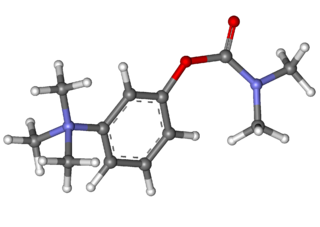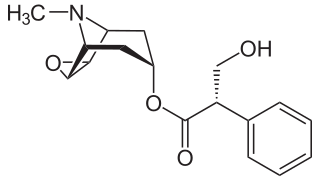
Atropine is a tropane alkaloid and anticholinergic medication used to treat certain types of nerve agent and pesticide poisonings as well as some types of slow heart rate, and to decrease saliva production during surgery. It is typically given intravenously or by injection into a muscle. Eye drops are also available which are used to treat uveitis and early amblyopia. The intravenous solution usually begins working within a minute and lasts half an hour to an hour. Large doses may be required to treat some poisonings.

Benzatropine (INN), known as benztropine in the United States and Japan, is a medication used to treat movement disorders like parkinsonism and dystonia, as well as extrapyramidal side effects of antipsychotics, including akathisia. It is not useful for tardive dyskinesia. It is taken by mouth or by injection into a vein or muscle. Benefits are seen within two hours and last for up to ten hours.
Anticholinergics are substances that block the action of the acetylcholine (ACh) neurotransmitter at synapses in the central and peripheral nervous system.

Pilocarpine is a medication used to reduce pressure inside the eye and treat dry mouth. As an eye drop it is used to manage angle closure glaucoma until surgery can be performed, ocular hypertension, primary open angle glaucoma, and to constrict the pupil after dilation. However, due to its side effects it is no longer typically used for long-term management. Onset of effects with the drops is typically within an hour and lasts for up to a day. By mouth it is used for dry mouth as a result of Sjögren syndrome or radiation therapy.

Neostigmine, sold under the brand name Bloxiverz, among others, is a medication used to treat myasthenia gravis, Ogilvie syndrome, and urinary retention without the presence of a blockage. It is also used in anaesthesia to end the effects of non-depolarising neuromuscular blocking medication. It is given by injection either into a vein, muscle, or under the skin. After injection effects are generally greatest within 30 minutes and last up to 4 hours.

Muscarinic acetylcholine receptors, or mAChRs, are acetylcholine receptors that form G protein-coupled receptor complexes in the cell membranes of certain neurons and other cells. They play several roles, including acting as the main end-receptor stimulated by acetylcholine released from postganglionic fibers in the parasympathetic nervous system.

Dicycloverine, also known as dicyclomine, sold under the brand name Bentyl among others, is a medication that is used to treat spasms of the intestines such as occur in irritable bowel syndrome. It is taken by mouth or by injection into a muscle. While it has been used in baby colic and enterocolitis, evidence does not support these uses.

Ipratropium bromide, sold under the trade name Atrovent among others, is a type of anticholinergic medication which is applied by different routes: inhaler, nebulizer, or nasal spray, for different reasons.

Tolterodine, sold under the brand name Detrol among others, is a medication used to treat frequent urination, urinary incontinence, or urinary urgency. Effects are seen within an hour. It is taken by mouth.

Hyoscine butylbromide, also known as scopolamine butylbromide and sold under the brandname Buscopan among others, is an anticholinergic medication used to treat abdominal pain, esophageal spasms, bladder spasms, biliary colic, and renal colic. It is also used to improve excessive respiratory secretions at the end of life. Hyoscine butylbromide can be taken by mouth, injection into a muscle, or into a vein.

Bronchoconstriction is the constriction of the airways in the lungs due to the tightening of surrounding smooth muscle, with consequent coughing, wheezing, and shortness of breath.

Chlorprothixene, sold under the brand name Truxal among others, is a typical antipsychotic of the thioxanthene group.

Oxybutynin, sold as under the brand name Ditropan among others, is an anticholinergic drug primarily used to treat overactive bladder. It is widely considered a first-line therapy for overactive bladder due to its well-studied side effect profile, broad applicability, and continued efficacy over long periods of time. It works similar to tolterodine, darifenacin, and solifenacin, although it is usually preferred over these medications. It is sometimes used off-label for treatment of hyperhidrosis, or excessive sweating. It has also been used off-label to treat bed wetting in children, but this use has declined, as it is most likely ineffective in this role. It is taken by mouth or applied to the skin.

A muscarinic agonist is an agent that activates the activity of the muscarinic acetylcholine receptor. The muscarinic receptor has different subtypes, labelled M1-M5, allowing for further differentiation.

Propantheline bromide (INN) is an antimuscarinic agent used for the treatment of excessive sweating (hyperhidrosis), cramps or spasms of the stomach, intestines (gut) or bladder, and involuntary urination (enuresis). It can also be used to control the symptoms of irritable bowel syndrome and similar conditions. This agent can also be used for patients who experience intense GI symptoms while tapering off of TCAs.

Solifenacin, sold as the brand name Vesicare among others, is a medicine used to treat overactive bladder and neurogenic detrusor overactivity (NDO). It may help with incontinence, urinary frequency, and urinary urgency.

A muscarinic receptor antagonist (MRA), also called an antimuscarinic, is a type of anticholinergic agent that blocks the activity of the muscarinic acetylcholine receptor. The muscarinic receptor is a protein involved in the transmission of signals through certain parts of the nervous system, and muscarinic receptor antagonists work to prevent this transmission from occurring. Notably, muscarinic antagonists reduce the activation of the parasympathetic nervous system. The normal function of the parasympathetic system is often summarised as "rest-and-digest", and includes slowing of the heart, an increased rate of digestion, narrowing of the airways, promotion of urination, and sexual arousal. Muscarinic antagonists counter this parasympathetic "rest-and-digest" response, and also work elsewhere in both the central and peripheral nervous systems.
Beclometasone/formoterol/glycopyrronium, sold under the brand name Trimbow among others, is an inhalable fixed-dose combination medication for the treatment of chronic obstructive pulmonary disease (COPD) and asthma. It contains beclometasone dipropionate, formoterol fumarate dihydrate, and glycopyrronium bromide.
Autonomic drugs can either inhibit or enhance the functions of the parasympathetic and sympathetic nervous systems. This type of drug can be used to treat a wide range of diseases, such as glaucoma, asthma, urinary, gastrointestinal and cardiopulmonary disorders.

Cholinergic blocking drugs are a group of drugs that block the action of acetylcholine (ACh), a neurotransmitter, in synapses of the cholinergic nervous system. They block acetylcholine from binding to cholinergic receptors, namely the nicotinic and muscarinic receptors.
















